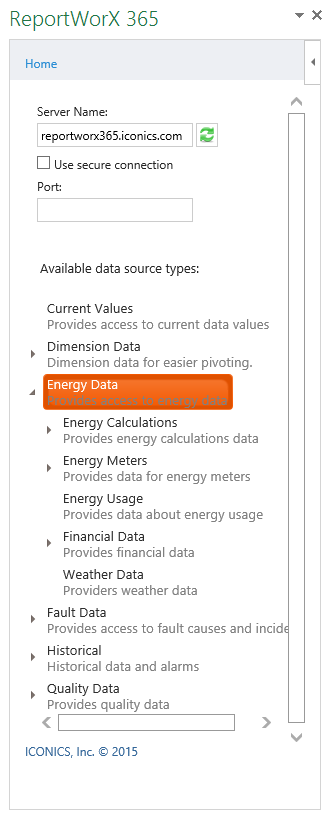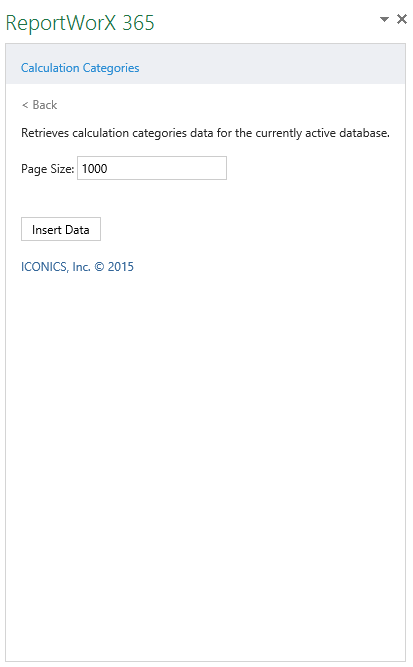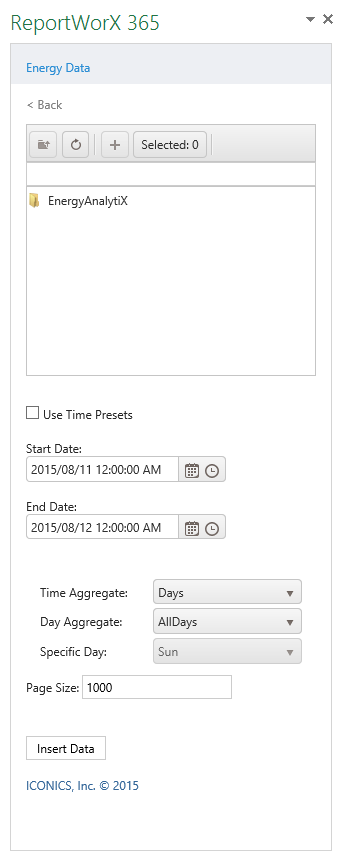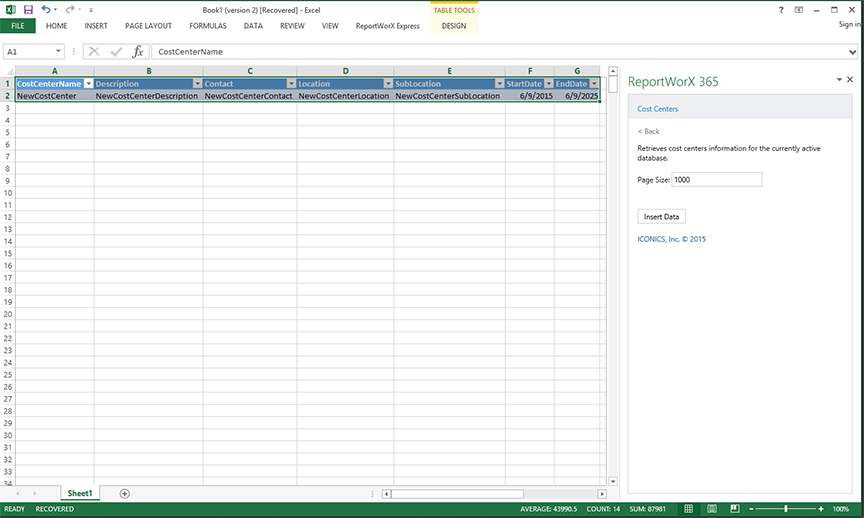|
|
The features on this page require a GENESIS64 Advanced license and are not available with GENESIS64 Basic SCADA . |
|
|
The features on this page require a GENESIS64 Advanced license and are not available with GENESIS64 Basic SCADA . |
Selecting Energy Data as a data source in ReportWorX 365 allows you to pick from either Energy Calculations, Energy Meters, Energy Usage, Financial Data, or Weather Data. Any of these sources provides access to energy data for use within Microsoft Excel.
Energy Data Selected in ReportWorX 365

The Energy Calculations data source provides energy calculations data for use within Microsoft Excel. The Energy Calculations data source can also be expanded for the selection of either Calculation Categories or Calculations Info.
To Configure an Energy Calculations Report:
Open the ReportWorX 365 add-in in Microsoft Excel. (See Installing ReportWorX 365 for more info). Place your cursor within the Microsoft Excel sheet where you wish the report data to appear.
In the ReportWorX 365 add-in, select the Energy Data data source type, and then the Energy Calculations data source type, as shown below.
Energy Calculations Selected

The Energy Calculations task pane appears on the right-hand side of your screen, as shown below.
Configuring Energy Calculations Report

The Energy (Calculations) Data data source within ReportWorX 365 retrieves asset information for the currently active database.
Users can utilize the file explorer section of ReportWorX 365 to navigate to their desired data source.
The following navigation items can be used:
 - Move up one folder level in the file explorer
- Move up one folder level in the file explorer
 - Move to the top folder level in the file explorer
- Move to the top folder level in the file explorer
 - Add the selected item. Note that you can add multiple contiguous items by holding the Shift key or multiple individual items by holding the Ctrl key.
- Add the selected item. Note that you can add multiple contiguous items by holding the Shift key or multiple individual items by holding the Ctrl key.
 - This button updates with the number of selected items. Clicking the button when one or more items have been selected changes the file explorer view to a file selection view, showing the data source items that have been added via the
- This button updates with the number of selected items. Clicking the button when one or more items have been selected changes the file explorer view to a file selection view, showing the data source items that have been added via the  button. In the file selection view, you can remove any selected data source by clicking on the [X] button to the right of its name.
button. In the file selection view, you can remove any selected data source by clicking on the [X] button to the right of its name.
Use Time Presets - Click this checkbox to activate a pulldown menu, shown below, to select a time preset [CurrentDay, CurrentMonth, CurrentWeek, CurrentYear, None, PreviousDay, PreviousMonth, PreviousWeek, PreviousYear].

Start Date - Enter a start date for the requested data in the text entry field. Or, click on the  to open the date selector tool and select a date and/or click on the
to open the date selector tool and select a date and/or click on the  to open the time selector tool and select a time.
to open the time selector tool and select a time.
End Date - Enter an end date for the requested data in the text entry field. Or, click on the  to open the date selector tool and select a date and/or click on the
to open the date selector tool and select a date and/or click on the  to open the time selector tool and select a time.
to open the time selector tool and select a time.
Time Aggregate - Use the pulldown menu to select from BaseSummary, Days, EntireInterval, Hours, Months, Weeks, or Years.
Day Aggregate - Use the pulldown menu to select from AllDays, SpecificDay, WeekdaysOnly or WeekendDaysOnly.
Specific Day - If SpecificDay was selected in the Day Aggregate menu, use this pulldown menu for the selection.
Derived Calculation - Click this checkbox if you wish to select a Data Aggregate.
Data Aggregate - Use the pulldown menu to select from Average, Last, Max, Min, None and Sum.
Retrieve Children - Click this checkbox to retrieve the children of any selected assets/data sources.
Page Size - Enter a page size for the retrieved data to be displayed within the current Microsoft Excel workbook. The default is 1000.
 - This button completes the process by inserting the selected data to the cell(s) selected in the main section of Microsoft Excel.
- This button completes the process by inserting the selected data to the cell(s) selected in the main section of Microsoft Excel.
Once you have clicked the Insert Data button, the report (the combination of column headers and requested data) should appear in the specified location.
Energy Calculations Data Report Example in Microsoft Excel

The Calculation Categories data source provides information about configured calculation categories.
To Configure a Calculation Categories Report:
Open the ReportWorX 365 add-in in Microsoft Excel. (See Installing ReportWorX 365 for more info). Place your cursor within the Microsoft Excel sheet where you wish the report data to appear.
In the ReportWorX 365 add-in, select the Energy Data data source type, then the Energy Calculations data source type, then the Calculation Categories data source type as shown below.
Calculation Categories Selected

Configuring Report Containing Calculation Categories

The Calculation Categories data source within ReportWorX 365 retrieves calculation categories data for the currently active database.
Page Size - Enter a page size for the retrieved data to be displayed within the current Microsoft Excel workbook. The default is 1000.
 - This button completes the process by inserting the selected data to the cell(s) selected in the main section of Microsoft Excel.
- This button completes the process by inserting the selected data to the cell(s) selected in the main section of Microsoft Excel.
Once you have clicked the Insert Data button, the report (the combination of column headers and requested data) should appear in the specified location.
Calculation Categories Report Example in Microsoft Excel

The Calculations Info data source provides information about configured calculations.
To Configure a Calculations Info Report:
Open the ReportWorX 365 add-in in Microsoft Excel. (See Installing ReportWorX 365 for more info). Place your cursor within the Microsoft Excel sheet where you wish the report data to appear.
In the ReportWorX 365 add-in, select the Energy Data data source type, then the Energy Calculations data source type, then the Calculations Info data source type as shown below.
Calculations Info Selected

Configuring Report Containing Calculations Info

The Calculations Info data source within ReportWorX 365 retrieves calculation information from the currently active database.
Page Size - Enter a page size for the retrieved data to be displayed within the current Microsoft Excel workbook. The default is 1000.
 - This button completes the process by inserting the selected data to the cell(s) selected in the main section of Microsoft Excel.
- This button completes the process by inserting the selected data to the cell(s) selected in the main section of Microsoft Excel.
Once you have clicked the Insert Data button, the report (the combination of column headers and requested data) should appear in the specified location.
Calculations Info Report Example in Microsoft Excel

The Energy Meters data source provides data from energy meters for use within Microsoft Excel. The Energy Meters data source can also be expanded for the selection of Meter Types.
To Configure an Energy Meters Report:
Open the ReportWorX 365 add-in in Microsoft Excel. (See Installing ReportWorX 365 for more info). Place your cursor within the Microsoft Excel sheet where you wish the report data to appear.
In the ReportWorX 365 add-in, select the Energy Data data source type, and then the Energy Meters data source type, as shown below.
Energy Meters Selected

The Energy Data (Meters) task pane appears on the right-hand side of your screen, as shown below.
Configuring Energy Meters Report

The Energy Data (Meters) data source within ReportWorX 365 retrieves energy meter information for the currently active database.
Users can utilize the file explorer section of ReportWorX 365 to navigate to their desired data source.
The following navigation items can be used:
 - Move up one folder level in the file explorer
- Move up one folder level in the file explorer
 - Move to the top folder level in the file explorer
- Move to the top folder level in the file explorer
 - Add the selected item. Note that you can add multiple contiguous items by holding the Shift key or multiple individual items by holding the Ctrl key.
- Add the selected item. Note that you can add multiple contiguous items by holding the Shift key or multiple individual items by holding the Ctrl key.
 - This button updates with the number of selected items. Clicking the button when one or more items have been selected changes the file explorer view to a file selection view, showing the data source items that have been added via the
- This button updates with the number of selected items. Clicking the button when one or more items have been selected changes the file explorer view to a file selection view, showing the data source items that have been added via the  button. In the file selection view, you can remove any selected data source by clicking on the [X] button to the right of its name.
button. In the file selection view, you can remove any selected data source by clicking on the [X] button to the right of its name.
Use Time Presets - Click this checkbox to activate a pulldown menu, shown below, to select a time preset [CurrentDay, CurrentMonth, CurrentWeek, CurrentYear, None, PreviousDay, PreviousMonth, PreviousWeek, PreviousYear].

Start Date - Enter a start date for the requested data in the text entry field. Or, click on the  to open the date selector tool and select a date and/or click on the
to open the date selector tool and select a date and/or click on the  to open the time selector tool and select a time.
to open the time selector tool and select a time.
End Date - Enter an end date for the requested data in the text entry field. Or, click on the  to open the date selector tool and select a date and/or click on the
to open the date selector tool and select a date and/or click on the  to open the time selector tool and select a time.
to open the time selector tool and select a time.
Time Aggregate - Use the pulldown menu to select from BaseSummary, Days, EntireInterval, Hours, Months, Weeks, or Years.
Day Aggregate - Use the pulldown menu to select from AllDays, SpecificDay, WeekdaysOnly or WeekendDaysOnly.
Specific Day - If SpecificDay was selected in the Day Aggregate menu, use this pulldown menu for the selection.
Derived Calculation - Click this checkbox if you wish to select a Data Aggregate.
Data Aggregate - Use the pulldown menu to select from Average, Last, Max, Min, None and Sum.
Retrieve Children - Click this checkbox to retrieve the children of any selected assets/data sources.
Page Size - Enter a page size for the retrieved data to be displayed within the current Microsoft Excel workbook. The default is 1000.
 - This button completes the process by inserting the selected data to the cell(s) selected in the main section of Microsoft Excel.
- This button completes the process by inserting the selected data to the cell(s) selected in the main section of Microsoft Excel.
Once you have clicked the Insert Data button, the report (the combination of column headers and requested data) should appear in the specified location.
Energy Meters Data Report Example in Microsoft Excel

The Meter Types data source provides information about configured meter types.
To Configure a Meter Types Report:
Open the ReportWorX 365 add-in in Microsoft Excel. (See Installing ReportWorX 365 for more info). Place your cursor within the Microsoft Excel sheet where you wish the report data to appear.
In the ReportWorX 365 add-in, select the Energy Data data source type, then the Energy Meters data source type, then the Meter Types data source type as shown below.
Meter Types Selected

Configuring Report Containing Meter Types

The Meter Types data source within ReportWorX 365 retrieves calculation information from the currently active database.
Page Size - Enter a page size for the retrieved data to be displayed within the current Microsoft Excel workbook. The default is 1000.
 - This button completes the process by inserting the selected data to the cell(s) selected in the main section of Microsoft Excel.
- This button completes the process by inserting the selected data to the cell(s) selected in the main section of Microsoft Excel.
Once you have clicked the Insert Data button, the report (the combination of column headers and requested data) should appear in the specified location.
Meter Types Report Example in Microsoft Excel

The Energy Usage data source provides data about energy usage.
To Configure a Date Dimension Report:
Energy Usage Selected

Configuring Report Containing Energy Usage

Report Type - Use the pulldown menu to select from either EnergyUse, ITEnergy or WaterUse.
Use Time Presets - Click this checkbox to activate a pulldown menu, shown below, to select a time preset [CurrentDay, CurrentMonth, CurrentWeek, CurrentYear, None, PreviousDay, PreviousMonth, PreviousWeek, PreviousYear].

Start Date - Enter a start date for the requested data in the text entry field. Or, click on the  to open the date selector tool and select a date and/or click on the
to open the date selector tool and select a date and/or click on the  to open the time selector tool and select a time.
to open the time selector tool and select a time.
End Date - Enter an end date for the requested data in the text entry field. Or, click on the  to open the date selector tool and select a date and/or click on the
to open the date selector tool and select a date and/or click on the  to open the time selector tool and select a time.
to open the time selector tool and select a time.
Page Size - Enter a page size for the retrieved data to be displayed within the current Microsoft Excel workbook. The default is 1000.
 - This button completes the process by inserting the selected data to the cell(s) selected in the main section of Microsoft Excel.
- This button completes the process by inserting the selected data to the cell(s) selected in the main section of Microsoft Excel.
Once you have clicked the Insert Data button, the report (the combination of column headers and requested data) should appear in the specified location.
Energy Usage Report Example in Microsoft Excel

The Financial Data data source provides financial data for use within Microsoft Excel. The Financial Data data source can also be expanded for the selection of Cost Centers.
To Configure a Financial Data Report:
Financial Data Selected

Configuring Financial Data Report

Users can utilize the file explorer section of ReportWorX 365 to navigate to their desired data source.
The following navigation items can be used:
 - Move up one folder level in the file explorer
- Move up one folder level in the file explorer
 - Move to the top folder level in the file explorer
- Move to the top folder level in the file explorer
 - Add the selected item. Note that you can add multiple contiguous items by holding the Shift key or multiple individual items by holding the Ctrl key.
- Add the selected item. Note that you can add multiple contiguous items by holding the Shift key or multiple individual items by holding the Ctrl key.
 - This button updates with the number of selected items. Clicking the button when one or more items have been selected changes the file explorer view to a file selection view, showing the data source items that have been added via the
- This button updates with the number of selected items. Clicking the button when one or more items have been selected changes the file explorer view to a file selection view, showing the data source items that have been added via the  button. In the file selection view, you can remove any selected data source by clicking on the [X] button to the right of its name.
button. In the file selection view, you can remove any selected data source by clicking on the [X] button to the right of its name.
Use Time Presets - Click this checkbox to activate a pulldown menu, shown below, to select a time preset [CurrentDay, CurrentMonth, CurrentWeek, CurrentYear, None, PreviousDay, PreviousMonth, PreviousWeek, PreviousYear].

Start Date - Enter a start date for the requested data in the text entry field. Or, click on the  to open the date selector tool and select a date and/or click on the
to open the date selector tool and select a date and/or click on the  to open the time selector tool and select a time.
to open the time selector tool and select a time.
End Date - Enter an end date for the requested data in the text entry field. Or, click on the  to open the date selector tool and select a date and/or click on the
to open the date selector tool and select a date and/or click on the  to open the time selector tool and select a time.
to open the time selector tool and select a time.
Time Aggregate - Use the pulldown menu to select from BaseSummary, Days, EntireInterval, Hours, Months, Weeks, or Years.
Day Aggregate - Use the pulldown menu to select from AllDays, SpecificDay, WeekdaysOnly or WeekendDaysOnly.
Specific Day - If SpecificDay was selected in the Day Aggregate menu, use this pulldown menu for the selection.
Derived Calculation - Click this checkbox if you wish to select a Data Aggregate.
Retrieve Children - Click this checkbox to retrieve the children of any selected assets/data sources.
Page Size - Enter a page size for the retrieved data to be displayed within the current Microsoft Excel workbook. The default is 1000.
 - This button completes the process by inserting the selected data to the cell(s) selected in the main section of Microsoft Excel.
- This button completes the process by inserting the selected data to the cell(s) selected in the main section of Microsoft Excel.
Once you have clicked the Insert Data button, the report (the combination of column headers and requested data) should appear in the specified location.
Financial Data Report Example in Microsoft Excel

The Cost Centers data source provides information about configured meter types.
To Configure a Cost Centers Report:
Cost Centers Selected

Configuring Report Containing Cost Centers

The Cost Centers data source within ReportWorX 365 retrieves cost centers information from the currently active database.
Page Size - Enter a page size for the retrieved data to be displayed within the current Microsoft Excel workbook. The default is 1000.
 - This button completes the process by inserting the selected data to the cell(s) selected in the main section of Microsoft Excel.
- This button completes the process by inserting the selected data to the cell(s) selected in the main section of Microsoft Excel.
Once you have clicked the Insert Data button, the report (the combination of column headers and requested data) should appear in the specified location.
Cost Centers Report Example in Microsoft Excel

The Weather Data data source provides weather data for use within Microsoft Excel.
To Configure a Weather Data Report:
Weather Data Selected

Configuring Weather Data Report

Users can utilize the file explorer section of ReportWorX 365 to navigate to their desired data source.
The following navigation items can be used:
 - Move up one folder level in the file explorer
- Move up one folder level in the file explorer
 - Move to the top folder level in the file explorer
- Move to the top folder level in the file explorer
 - Add the selected item. Note that you can add multiple contiguous items by holding the Shift key or multiple individual items by holding the Ctrl key.
- Add the selected item. Note that you can add multiple contiguous items by holding the Shift key or multiple individual items by holding the Ctrl key.
 - This button updates with the number of selected items. Clicking the button when one or more items have been selected changes the file explorer view to a file selection view, showing the data source items that have been added via the
- This button updates with the number of selected items. Clicking the button when one or more items have been selected changes the file explorer view to a file selection view, showing the data source items that have been added via the  button. In the file selection view, you can remove any selected data source by clicking on the [X] button to the right of its name.
button. In the file selection view, you can remove any selected data source by clicking on the [X] button to the right of its name.
Use Time Presets - Click this checkbox to activate a pulldown menu, shown below, to select a time preset [CurrentDay, CurrentMonth, CurrentWeek, CurrentYear, None, PreviousDay, PreviousMonth, PreviousWeek, PreviousYear].

Start Date - Enter a start date for the requested data in the text entry field. Or, click on the  to open the date selector tool and select a date and/or click on the
to open the date selector tool and select a date and/or click on the  to open the time selector tool and select a time.
to open the time selector tool and select a time.
End Date - Enter an end date for the requested data in the text entry field. Or, click on the  to open the date selector tool and select a date and/or click on the
to open the date selector tool and select a date and/or click on the  to open the time selector tool and select a time.
to open the time selector tool and select a time.
Time Aggregate - Use the pulldown menu to select from BaseSummary, Days, EntireInterval, Hours, Months, Weeks, or Years.
Day Aggregate - Use the pulldown menu to select from AllDays, SpecificDay, WeekdaysOnly or WeekendDaysOnly.
Specific Day - If SpecificDay was selected in the Day Aggregate menu, use this pulldown menu for the selection.
Page Size - Enter a page size for the retrieved data to be displayed within the current Microsoft Excel workbook. The default is 1000.
 - This button completes the process by inserting the selected data to the cell(s) selected in the main section of Microsoft Excel.
- This button completes the process by inserting the selected data to the cell(s) selected in the main section of Microsoft Excel.
Once you have clicked the Insert Data button, the report (the combination of column headers and requested data) should appear in the specified location.
Weather Data Report Example in Microsoft Excel

See Also: